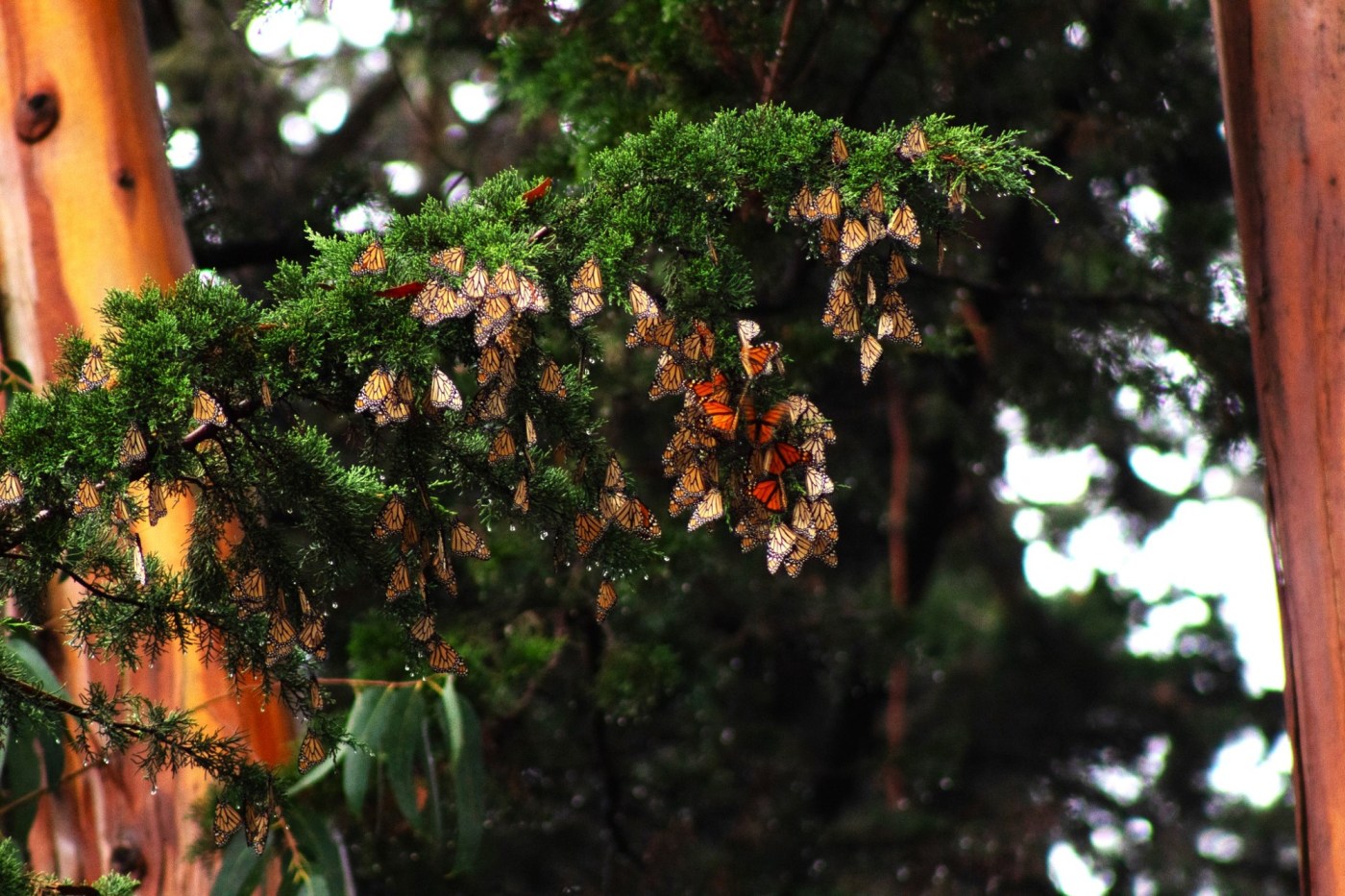After two consecutive years of increases, the population of Western monarch butterflies wintering along the California coast dropped by 30% in late 2023, according to numbers released on Tuesday, Jan. 30.
Spotters from the Portland-based Xerces Society for Invertebrate Conservation counted 233,394 of the iconic orange and black beauties at 256 sites in coastal California over three weeks in November and December 2023, finding about 102,000 fewer butterflies than the previous year.
A monarch butterfly sipping nectar from milkweed flower. (Getty Images)
The Western Monarch species (Danaus plexippus) of North America has made a miraculous recovery since 2020 when only 2,000 were counted. But the biologists note that they are still at just 5% of their population numbers from the 1980s when the counts found monarchs in the low millions in California.
“We can see the population is trending downward. In the 1980s we saw numbers in the low millions,” Isis Howard, a monarch conservation biologist familiar with the count, said on Tuesday, Jan. 30 in a webinar.
What caused the drop in numbers this past year?
Fluctuations in populations are common for this species, especially when numbers are already low. Survival rates can be affected by changes in rainfall, temperature, and the availability of plants containing nectar — a source of food — and of milkweed plants on which they lay their eggs, explained scientists with the Xerces Society.
Winter storms cut into breeding season in the spring when observers initially saw fewer butterflies. So finding fewer wintering butterflies was not a surprise, explained Emma Pelton, a monarch conservation biologist with the Xerces Society.
“It’s difficult to predict how conditions during any single year will influence the population, but we do know that Western Monarch numbers need to be much higher before we consider this a recovery,” Pelton said.
In fact, Pelton reported, “the bottom fell out” of the population starting in 2018 and reached the lowest number in the count’s history in 2020. “We were really afraid the migration had truly collapsed. But in the last few years we have seen an uptick,” Pelton said. “Though they’ve bounced back, but not fully, since they are down 95% from that historic normal.”
The Central Coast hosted the majority of these butterflies, about 76%, said Howard.
In the fall 2023 count, about 33,080 were counted at an overwintering site in Santa Barbara County owned by The Nature Conservancy that’s closed to the public. That site contained the largest number of butterflies in 2022 as well.
The second largest number at one site was 16,038 monarchs at the Pismo State Beach Monarch Butterfly Grove followed by 10,029 at the Morro Bay Golf Course in San Luis Obispo County, according to the count. The state beach still has 10,000 butterflies and is open to the public, the scientists reported.
Related Articles
Gov. Gavin Newsom backs dam removal projects aimed at sustaining salmon populations
Researchers off California coast report first sighting of newborn great white shark
Family of 85-year-old woman killed by alligator in her backyard files wrongful death lawsuit
What animal is making small holes in an Atherton garden?
Plans to preserve huge San Jose ranch take big new step
More than 400 volunteers helped conduct the 27th fall Western Monarch count. They checked sites where migrating butterflies cling, often hanging upside-down on branches of eucalyptus and other tree species. In January through March, the butterflies leave to mate, breed and begin the next generation.
Habitat loss, climate changed and the reduction in milkweed which is needed by monarchs for food and to lay their eggs, are some factors reducing the Western Monarch populations, said Pelton during the webinar on Tuesday.
“There have been 60 sites destroyed in the past 30 years,” Pelton said, including a site owned by Chevron Oil in which the eucalyptus trees were cut to the bark, leaving almost no leaves or branches. At Leo Carrillo State Beach in Los Angeles County, conservation efforts include replanting trees and native milkweeds that was lost in the devastating 2018 Woolsey Fire that burned 96,949 acres in Los Angeles and Ventura counties.
Pesticides and herbicides can also kill the butterflies or prevent ample reproduction. “Pesticide contamination in agricultural areas — but also there’s a lot of evidence of this in suburban and urban areas where use of pesticides sometimes occur at much higher rates,” Pelton explained.
The Xerces Society is familiar with anecdotal reports of many people from Southern California, Michigan and other states seeing an increase in the monarchs.
According to the count, Hermosa Beach hosted 1,349 butterflies in 2021 and 337 in 2022. On Harbor Boulevard in Ventura, counters spotted 5,547 in 2021 and 2,670 in 2022.
No data was available for these sites from the 2023 count. But biologists from the society said they’ve heard reports of more monarchs in Southern California this fall and winter. One reason could be a push by nurseries and nonprofits to plant more native milkweeds in backyard gardens and along common parkways.
“In Southern California, there has been an active resident population that has gotten bigger with more widespread planting of milkweed. But we don’t have a great handle on how those relate to the migration population,” said Pelton.
Brian Brown, curator of entomology at the Natural History Museums of Los Angeles County, said during the Christmas holidays he and his family spotted Western Monarchs at their vacation home in Los Osos, CA.
“There were a lot of monarchs even in areas where we don’t normally see them,” he said on Monday.
Howard was pleased that they are getting more reports of people seeing the distinctive butterfly. “It is encouraging more people are citing monarchs. It shows a greater awareness of the butterflies,” she said.
Monarch butterflies are studied annually because they can be a harbinger in the decline of other butterflies and other insect pollinators, Howard said.
They are well-known to many people. “They are relatable. This can bring people together at a time when there are many reasons to be divided,” Howard added.













+ There are no comments
Add yours